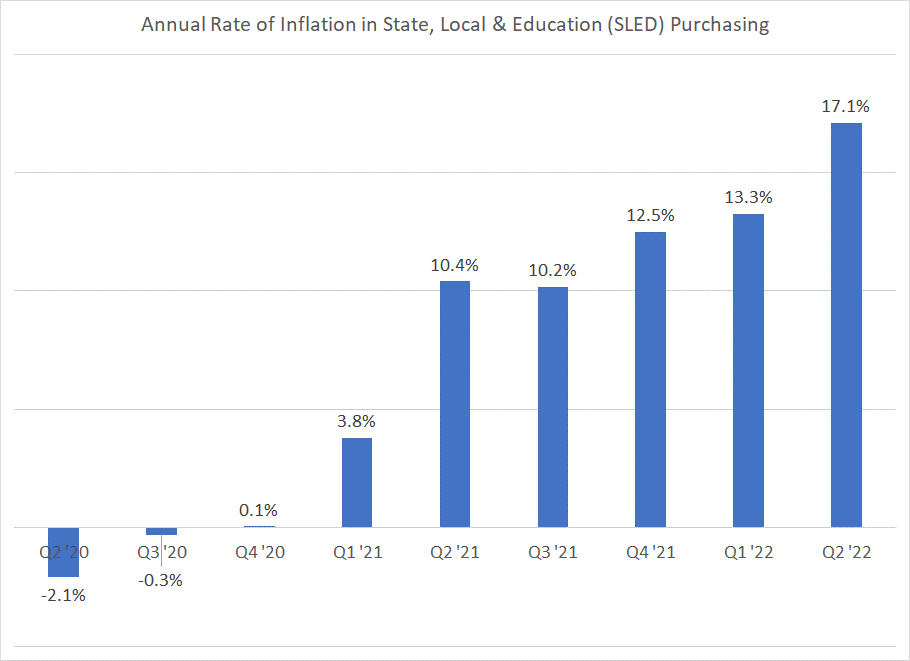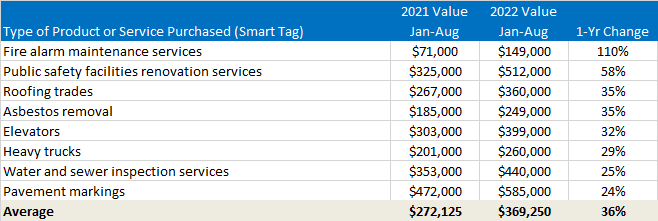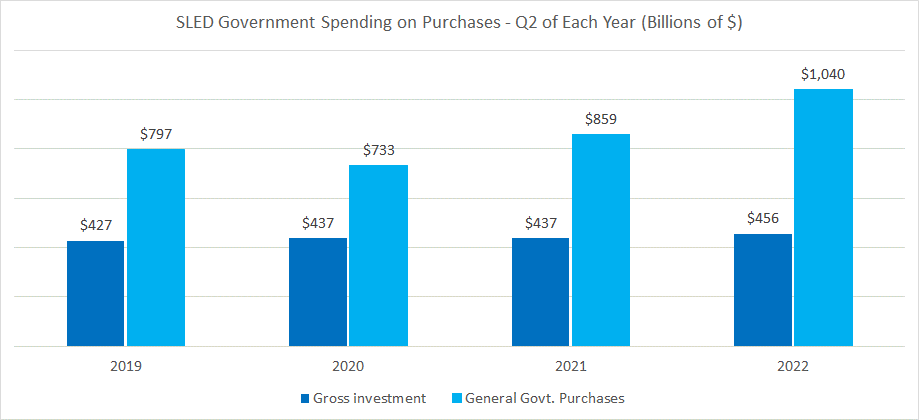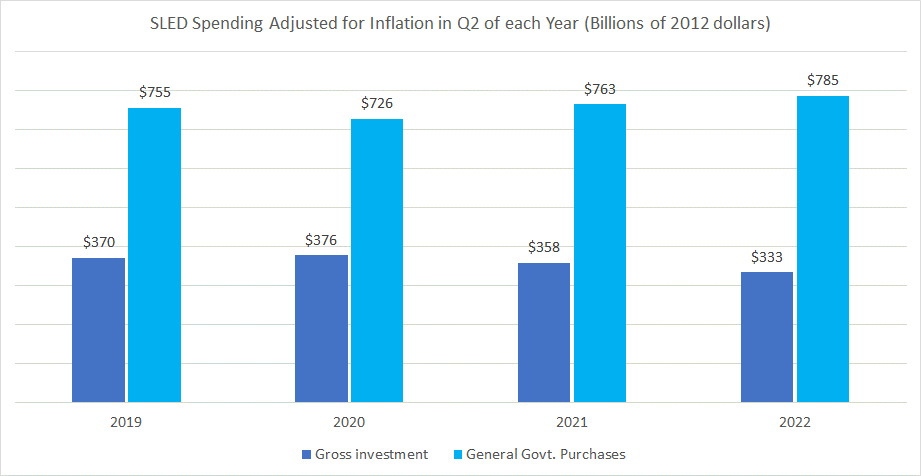
Unusually high inflation has caused great anxiety, forced a major revision of Federal Reserve direction on interest rates, rocked the stock markets, hurt consumers and placed downward pressure on the economy. But one place it has also affected is the $1.5 trillion state, local and education (SLED) government purchasing marketplace. In this special investigative article, Deltek’s research team behind GovWin IQ platform of government contracting intelligence will measure the impacts, examine the key drivers and identify ways that officials and procurement leaders are adjusting and navigating through this period.
The official U.S. rate of inflation of 8.3% in August 2022 (CPI) is basically the highest that has been measured since the oil crisis in the late 1970s. Within the business community the focus has been on coping with labor market imbalances, supply chain disruptions and higher costs for various raw materials and inputs needed to produce finished products and deliver services. However, there is an intriguing story of how inflation is affecting the purchasing or spending decisions of states, cities, counties, special districts, school districts and public colleges. SLED government has been facing greater than normal rates of inflation, yet has also in many ways been better protected in its ability to respond by the unusually robust stimulus packages of the pandemic era.
How Typical is SLED Government in Terms of Inflation Rates?
First, of all, we can start out by asking the question whether state, local and education governments are facing similar or different inflationary pressures compared to the typical consumer or overall U.S. economy. Recent data from the Bureau of Economic Analysis reveals a clear answer: Across all products and services, these governments are paying much higher prices for the things they need to buy versus the typical 8% rate of inflation measured in the broad Consumer Price Index. In fact, as of Q2 2022, it is estimated as being twice as much as normal—with an annual rate of 17.1% year-over-year. This factors in all of the components of purchasing from new roads and buildings to capital equipment to IT, basic commodity goods and services.
What Drives the Higher Overall Rate of Inflation
Looking deeper into the seven major categories reported by the official BEA data source, we find that two sub-categories really stand out as contributing to the higher overall average rate: Nondurable goods and structures. Outside of these two, the other five categories aren’t that different from the overall U.S. consumer inflation rate of 8%. Nondurable goods such as fuel, food, apparel and other basic commodities was 36% higher on average in Q2 ’22 year-over-year. This has been fairly steady over the past year, at around 27%-36%, but it really took off after Q1 ’21 when it was down at 9%, and it started the series at -15% in Q2 ’20 when the pandemic first hit. Structures, which encompasses spending on design, construction and renovation of roads, infrastructure and buildings, rose in prices by a healthy 14% in Q2 ’22, and has steadily risen from around 1% in the first few quarters after the arrival of COVID-19. Higher recent construction costs have stemmed not only from spikes in raw materials such as lumber but also labor market shortages in workers. In summary, it’s largely a commodity and construction story.
To give a better sense of what kinds of purchases are seeing these increases, we turned to our own comprehensive database of competitive bids and awards in SLED government and sorted recent awards using our system of approximately 4,000 Smart Tags that automatically classify purchases into very niche categories. The following table lists median average contract sizes to compare typical purchasing situations from 2021 to 2022 (Jan to Aug in each year). Using median rather than mean contract amounts help to avoid skewing by the few extremely large purchases and provides a better read on what is commonly being experienced.
For these eight example niche areas, SLED officials went from paying around $272,000 on average last year to $369,000 per purchase, for a 36% year-over-year increase. This happens to be the same as the 36% level of inflation in non-durable goods measured by the Bureau of Economic Analysis for Q2 ’22 but it includes other types such as services and equipment that normally have much lower rates of annual increases in the BEA data.
Examples of Specific Types of Purchases Seeing Large Increases in Average (Median) Contract Award Value
How SLED Governments are Coping with Higher Prices
Government leaders and heads of procurement have no doubt spent considerable time wrestling with how best to respond to the challenges of inflation while continuing to serve their communities and be responsible stewards with public funds. Governments at the state and local levels are known for finding solutions to problems, shifting resources around and innovating the “process” where needed. In the end, the public just expects everything to work well and operate smoothly regardless of what it takes or how much it costs.
The good news has been that substantial relief has come in the form of a resilient economy and tax revenues so far and unprecedented stimulus funding. While the future is not guaranteed and many expect a recession by 2023, the SLED market has managed to recover well in the face of what would otherwise have been a more severe downturn in spending dollars. Having a fairly healthy fiscal outlook has helped these governments keep up with inflation rather than fall behind in their service levels and commitments. Let’s take a look at two of the adjustments that were made based on these issues:
Adjustment #1: Keeping up with needs by spending “enough” for goods and services
According to the initial estimates from the Bureau of Economic Analysis, Q2 ’22 spending by SLED governments on all general government spending (which includes services, durable and nondurable goods) was up a whole 30% across the last three years, while gross investment on things like roads and capital equipment was up by a modest 7%. While the most recent rise in spending for general purchases looks extreme and unsustainable, it was pretty much solely concentrated on nondurable goods—the category that saw the 36% one-year inflation rate. It rose a full 57% in total spending over the three years from 2019 to 2022. Durable goods in turn increased 14% since 2019 and services rose by 17% over the three-year period shown in the chart.
The following two charts show annualized spending by SLED government based on purchasing taking place in the middle of each year.
The question of “is this increase in dollars enough to meet basic needs or is it ramping up to a higher level?” is answered by the next chart that is adjusted for inflation. Spending on general goods and services is now only up by 4% since 2019, or basically flat. Meanwhile, investment spending is down to 90% of normal for Q2 ’22. Bottom line: State, local and education governments are doing their best to keep up with inflation and still be able to purchase the basic items they need. They are somehow finding a way to boost spending to “keep the lights on” including all the rapidly inflating but essential non-durable goods, while remaining somewhat more cautious about longer-term capital investments.
The ability of these buyers to afford higher rates of spending in today’s dollars has to do with two key developments. First, it’s been reported that when the pandemic first hit in 2020, governments initially projected a much worse drop in revenue than what actually happened. 49 states have “reported fiscal 2022 general fund revenue collections are exceeding original budget forecasts” according to analysis by NASBO. Lacking good “apples to apples” historical examples to work with, planners had been extra conservative while at the same time the economy has held up fairly well. On the state government side, cash surpluses have resulted in many cases—which could be tapped to make more purchases. This trend of healthier cash balances helps explain why even in Q1 ’22 with the war in Ukraine starting and stock markets dropping, SLED government volumes of bids issued did not pull back at all but had one of their best quarters from a growth rate standpoint. While the world was quickly becoming more fearful, SLED government was clearly acting in a “bullish” or optimistic manner.
When COVID-19 arrived in Q2 ’20, with stocks cratering and massive layoffs, there was good reason for governments to be careful. But much of the excess caution apparently melted as a huge protective wall of new stimulus money came in, sales tax revenues increased from consumers flush with cash, business taxes grew from companies remaining open, and property taxes kept on rising from the lack of housing supply and “work from home” demand powering strong rises in home values. More recent stimulus packages included large amounts of dedicated funding just for SLED governments that did not have to be only spent directly to fight COVID. This included $350B ARPA funding, $550B net new funding in the Infrastructure Act and additional funding in the Inflation Reduction Act. In some cases, state governments have been issuing their own local forms of stimulus through handing out cash to their residents in some form, while the New York Times reports some have even been talking about making permanent changes to tax levels, which the Tax Policy Center notes may come back to haunt them should an actual recession emerge.
Adjustment #2. Rethinking how to buy Commodities and Construction
Commodities and highly standardized purchases have always been targets for buying in more efficient ways, from longer term flexible multi-purchase contracts to national cooperative contracts that can be bought off of by hundreds of buyers at any one time. Through Deltek’s contacts in the cooperative purchasing community and our own research, we know that sales of commodity items through the major co-ops have been growing faster than average over the past five plus years and did not slow in 2020 when the pandemic hit. While a five-year co-op contract for a commodity can potentially be renegotiated after a certain period to reflect fair market changes in costs, the prices you see listed online in their catalogues will normally remain that way for some time at a fixed level. This can be a tremendous help or tool for nervous government buyers who may wonder about their ability to afford to certain high-demand and highly inflationary commodities. In some cases, the issue may be not just the rising price but also even finding enough available sellers locally.
Each year GovWin offers our 10 Hotspots in Government Contracting report that examines the fastest growing trends in purchasing among SLED buyers. When we examined the 2019 versus 2020 years, we found a 47% increase in bids and RFPs issued for supply chain related services, which helped short-staffed SLED governments figure out how to procure many high demand commodities like PPE quickly and at reasonable prices. In our last Hotspots report covering the 2020-21 period, one of the fastest growing areas was making direct purchases of lumber and plywood for use by governments in various construction work. Specifically, there was a 130% increase in the number of direct purchases from 2020 to 2021. This helps reduce risk by taking control of the process itself, with the buyer purchasing the raw materials for contractors to use. It eliminates the markup, provides for potentially better volume pricing of the raw materials, and helps ensure that the cost estimates initially received for all of the other parts of the project will be more accurate—promoting value and accountability.
In some cases, contracts have escalation clauses that ensure any cost overruns that are not the fault of the builder and exceed a certain threshold (like 15% of the total price) must be paid for, which presents a challenge for the governments in trying to manage their budgets and deliverables. Since contractors often do not have this level of protection, they in turn must often take on higher liability and risk for potentially having to fulfil their responsibilities even at a loss. According to a recent report by the Associated General Contractors (AGC), increases in bid prices for non-residential construction (up 12% annually as of end of 2021) had failed to keep pace with increases in their costs of +19%. There is some evidence that certain states are working to address this issue, establishing reserve accounts to more easily pay for these overages when they occur. This can become a competitive advantage for a state or community that wants to appear “business friendly.” It can send a strong message that if a company goes ahead and commits to a project, the buyer will mitigate some of that risk and make sure they are not going to be forced to “eat it” if reality differs from expectation due to inflation. This can, in turn, open the door to greater competition and encourage more firms to respond when a competitive bid process is used.
Curious how inflation is impacting federal government contracting? Click the link below to download Deltek’s free report.

Deltek Project Nation Newsletter
Subscribe to receive the latest news and best practices across a range of relevant topics and industries.

 Log In
Log In














